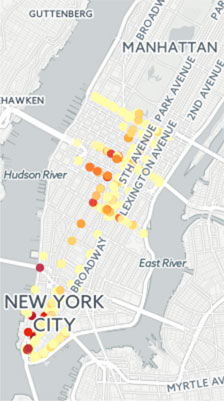For all intents and purposes, Staten Island's bus network is broken. Which isn't surprising when you consider that the borough's 31 local routes have barely changed in the last half-century. For the most part, ancient bus lines that pre-date the Verrazano Bridge (which opened in 1964) don’t go where people actually need to get around.

Then there are the express bus routes that take Staten Island commuters to and from Manhattan. These are some of the city's slowest and least reliable express buses, plagued by traffic jams and stops that are spaced too close together.
At the request of Borough President James Oddo, last summer the MTA announced a full-network study of all 51 bus lines serving Staten Island.
As part of the effort, Oddo and the MTA co-sponsored a “Bus Hackathon” with TransitCenter and NYU’s Rudin Center for Transportation on Saturday. They invited teams of software developers and tech-savvy urbanists to use MTA ridership data to diagnose problems and propose solutions for the borough’s bus system. The 150 participants cranked out 15 proposals for improving bus service, from which a panel of judges selected three winners.
TransitCenter's Jon Orcutt said the hack-a-thon was a way to "get a fresh set of eyes" on the problems plaguing buses serving not just Staten Island but all of New York City. Bus ridership has continued to decline in recent years even as subway ridership climbs to historic highs.
"A lot of things are the way they are because no one's taken a look at them in a long time," Orcutt said. "This isn't rocket science, but someone has to look at it."
Here's a look at some of the most enlightening analysis from the hack-a-thon -- you'll notice a lot of overlapping ideas. (TransitCenter also posted a summary today.)
“How to Optimize Express Bus Routes in Staten Island”
Sri Kanajan showed that large numbers of riders get on and off express buses at a relatively small number of stops in Manhattan. Consolidating express bus stops in Manhattan could save passengers time with minimal impact on the walking leg of most people's trips.
This proposal would re-orient the express bus network around a few trunk lines with much more frequent service than the current routes, cutting down on wait times without additional costs.
In a similar vein, this submission would consolidate express bus service in a simplified network of high-frequency routes that connect several points, or hubs, on Staten Island. The team designed the network based on current ridership and the location of housing and jobs on Staten Island.

You can view all 15 submissions on the event's DevPost page.





